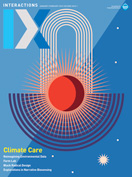Authors:
Mikael Wiberg, Alex Taylor, Daniela Rosner
An issue on climate needs no introduction. Shockingly, it feels like a platitude to say that we are in the midst of a climate crisis that necessitates profound changes to the ways all of us, globally, live. Nevertheless, it is time to act. Given the challenges we are facing with ongoing climate changes, including a global temperature rise, wildfires, pollution, extreme weather conditions, and drastic changes in the ecosystem, we need to move from speculating about what is happening to nurturing conditions for tackling these challenges systemically. This is not, however, a call for quick fixes. Climate is different from weather in that it is about slow, long-term changes. Accordingly, we need long-term agendas for how to move forward.
In moving forward, we in the technology sector (and those connected to it, no matter how tenuously) must resist the temptation to be complacent. If taking action, we need to do so reflectively and self-critically; accordingly, we need to ask difficult questions of our industry and our own practices, and these questions must urgently lead to real changes. How, then, does our work contribute to a rise in global temperatures, and what can we do to change this? Where are the disruptive effects of our work felt most intensely and by whom? Can we invent our way out of catastrophe? And what must change?
Over the past few years, we have seen a number of promising approaches being developed in our field—from collapse informatics to sustainable HCI to approaches that have foregrounded care for the climate. We see an emergent strand of research on more-than-human-centered approaches to design, and there are calls for reimagining and designing for alternative futures. In short, we are moving toward alternative design agendas, and this is a much-needed movement. In this issue on climate care, we suggest that "to care for something" goes beyond problem-solving. As many critical disability and Indigenous studies scholars have shown, to care is to notice, to pay attention to, to get involved in, and to be engaged with. Care can also be about having concerns—to be cautious, worried, and emotionally entangled with. Climate care is therefore not an issue we need to "address" but rather something we need to be engaged in.
In this stimulating issue, practitioners and scholars in design and HCI take this perspective as their point of departure. In the first of our Dialogue Standpoints, Ann Light provokes us to subvert interaction design by thinking globally about climate change. She recognizes that the urge to find technological fixes cannot replace the pressing need to situate our actions and accompanying visions in and against worlds that are, at the same time, extractive and full of hope. Andrea Botero Cabrera, Markéta Dolejšová, Jaz Hee-jeong Choi, and Cristina Ampatzidou show how the rich and deeply felt experiences of places—in their case, forests—sit alongside data. Responding to Ann Light's calls, they rely on the creative impulse to reengage actors of all kinds in the ongoing work of voicing other stories, and the possibilities of other more-than-human worlds.
To be read, possibly, as a tutorial for this creative thinking, Robert Soden's "Reimagining Environmental Data" gives readers six steps that we can take to rethink the data we produce with technology, and through this create the conditions for, as he puts it, imagining "things to be otherwise." Another of this issue's Standpoints has Jen Liu spin a tale through her work in Louisiana. This brings us back to Ann Light's calls for attention to place. Liu reminds us that places cannot be divorced from their people, and the lands and labors that have shaped them. Through these pieces, we come to see that, while being global, the actions needed must be grounded in bodies, labors, and places, and the always unfolding stories that bind them together.
Accompanying this issue's four Dialogue pieces is the content in our Enter section. Again, together, the works here speak to the experiential and interpersonal in our relations to bodies—our own bodies (in Gabrielle Benabdallah and Blair Subbaraman's "Explorations in Narrative Biosensing"), the soil (in Henry Driver's "Secrets of Soil"), and communities collectively growing food and facing the effects of regional heat waves (in Phil Nichols and Sara Heitlinger's "Farm Lab" and Aalok Khandekar's "What Are You Reading?"). The rich imagery and words show how and where connections are made and sustained in our ongoing relations with others. They show where bodies, labors, and places can connect.
Crucially, what our contributors in this issue draw our attention to is a care for the worlds we encounter and live in. They show that we must care, and that to care is to be bodily invested, to make connections that matter, and to discover a solidarity with others of all kinds—for an earthbound flourishing.
Mikael Wiberg, Alex Taylor, Daniela Rosner [email protected]
Copyright held by authors
The Digital Library is published by the Association for Computing Machinery. Copyright © 2022 ACM, Inc.








Post Comment
No Comments Found